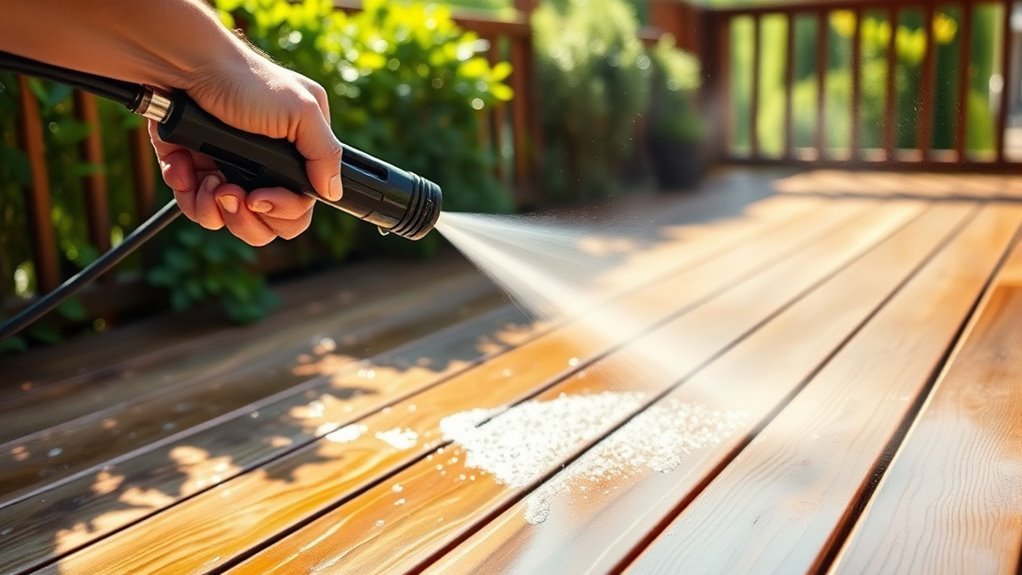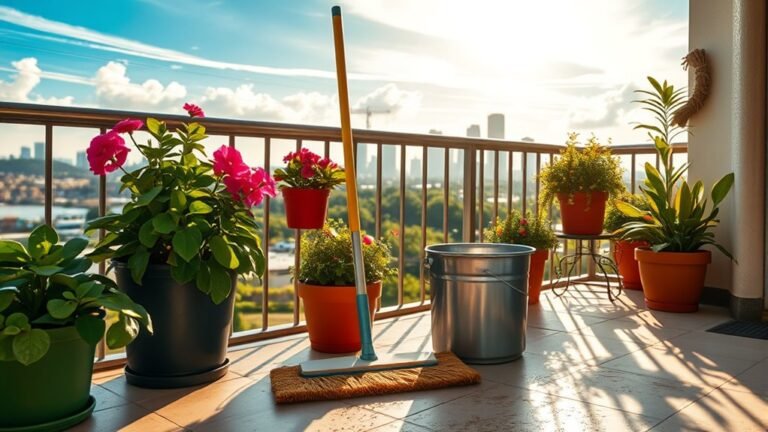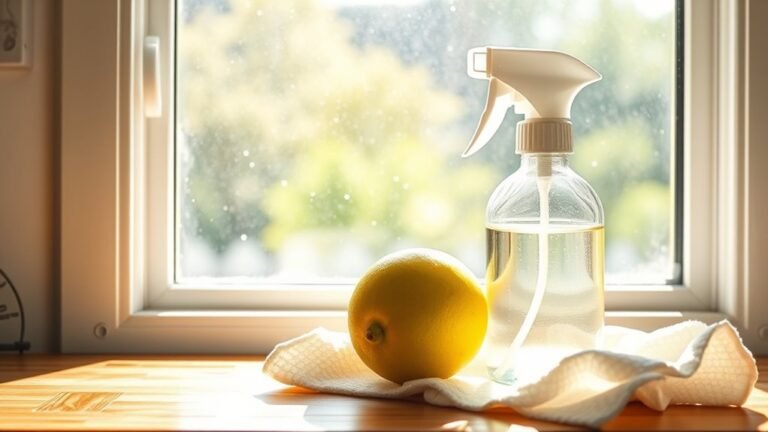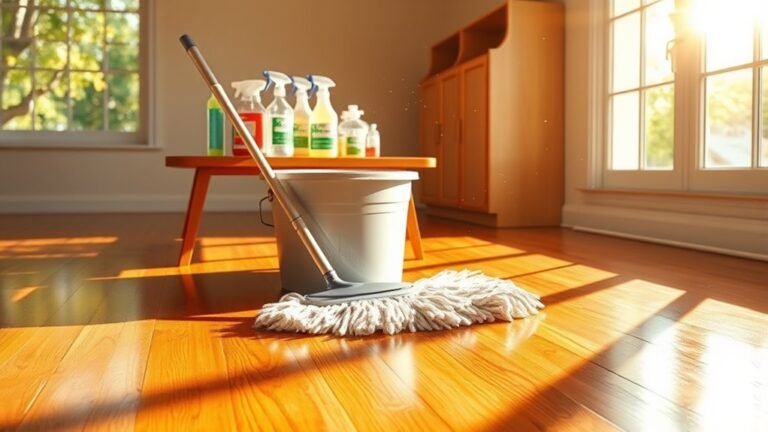How to Power Wash Your Deck Without Damage
To power wash your deck without damage, choose an electric model with adjustable pressure and a 25° or 40° nozzle for gentler cleaning. Clear the deck of furniture and debris, and inspect for damage before starting. Keep the nozzle at least 12 inches away, using moderate pressure around 500-600 psi to avoid stripping wood fibers. After washing, let the deck dry fully and consider sealing it for protection. Keep these basics in mind as you explore more tips to preserve your deck’s beauty.
Choosing the Right Power Washer for Your Deck

Before you begin power washing your deck, it’s important to pick the right power washer for the job. You’ll want to weigh electric vs gas models carefully. Electric power washers are lighter, quieter, and require less maintenance, perfect if you want hassle-free freedom without fumes. Gas models pack more punch, offering higher pressure and mobility, ideal if your deck is large or heavily stained. Consider power washer features like adjustable pressure settings, nozzle types, and hose length to tailor the cleaning power to your deck’s needs. Choosing the right balance between power and control guarantees you can clean effectively without causing damage. By selecting the best power washer upfront, you set yourself up for a smooth, liberating deck cleaning experience.
Preparing Your Deck for Power Washing
Before you start power washing, make sure to clear everything off your deck to avoid any damage. Take a close look for any cracks, loose boards, or nails that need fixing. Addressing these issues first will help protect your deck during the cleaning process.
Clear Deck Surface
To get your deck ready for power washing, start by removing all furniture, plants, and decorations from the surface. This step is vital for effective deck surface preparation and guarantees deck surface protection during cleaning. Clear any debris like leaves or dirt by sweeping thoroughly. This prevents damage and allows the water pressure to work evenly.
| Task | Purpose | Tip |
|---|---|---|
| Remove Furniture | Prevent damage | Store indoors or cover |
| Clear Debris | Avoid clogging | Use a broom or blower |
| Check for Loose Items | Confirm safety | Secure or remove |
Inspect for Damages
Once your deck is cleared and debris-free, take a close look for any damage that might need attention. Check the deck surface for cracks, splinters, or loose boards that could worsen under the pressure of a power washer. Don’t overlook signs of rot or decay, especially around the edges and joints. Ensuring the structural integrity of your deck is essential—not just for safety but to avoid costly repairs later. If you spot any weak spots or nails popping up, fix them before you start washing. Taking this step frees you from unexpected setbacks and lets you enjoy a smooth, effective cleaning process. Remember, a well-maintained deck not only looks great but supports your freedom to relax confidently outdoors.
Selecting the Appropriate Pressure Setting

Although it might be tempting to use the highest pressure setting for a quick clean, selecting the right pressure is essential to avoid damaging your deck’s wood. You want to maintain freedom in your cleaning process, but that means respecting the material. Start by checking your power washer’s pressure gauge to understand its default output. Most decks respond well to a pressure between 500 and 600 psi. Use the setting adjustments on your machine to dial down from the maximum power. Too much pressure can gouge the wood or strip away the finish, so keep it balanced. By carefully controlling the pressure, you’ll get a thorough clean without sacrificing your deck’s integrity or your freedom to enjoy it afterward.
Using the Correct Nozzle for Deck Cleaning
Choosing the right nozzle is key to protecting your deck while getting it clean. Different nozzle types offer various spray angles and pressure levels, so picking the ideal one helps you avoid damage. Let’s look at how these nozzles affect the cleaning power and what spray angles work best for your deck.
Nozzle Types Overview
There are five common nozzle types you’ll encounter when power washing your deck, each designed for a specific spray pattern and pressure level. Choosing the right nozzle size and considering nozzle materials can make your cleaning efficient without damaging your wood. Different spray angles help you control pressure and coverage, freeing you to tackle tough grime or gentle rinses.
| Nozzle Type | Spray Angle & Use |
|---|---|
| 0° (Red) | Pinpoint, high pressure for tough stains |
| 15° (Yellow) | Narrow fan, good for stripping paint |
| 25° (Green) | Medium fan, ideal for general cleaning |
| 40° (White) | Wide fan, gentle rinsing |
| Soap (Black) | Low pressure, for applying detergents |
Pick your nozzle wisely to protect your deck and enjoy the freedom of a spotless outdoor space.
Pressure Settings Impact
Understanding how pressure settings interact with your nozzle choice can make a big difference in protecting your deck while getting it clean. You want enough power to remove dirt and grime but not so much that you cause damage. Using a high-pressure setting with a narrow nozzle might strip wood fibers or etch soft surfaces, leading to costly repairs. Instead, match moderate pressure settings with a wider spray nozzle to distribute force evenly. This combo helps lift dirt without gouging the wood, ensuring damage prevention while maintaining your deck’s natural beauty. By adjusting pressure settings thoughtfully and picking the right nozzle, you keep your deck safe and free, letting you enjoy your outdoor space without worry or restriction.
Ideal Spray Angles
Although it might seem minor, the angle at which you spray your deck plays an essential role in effective cleaning and preventing damage. When you adjust your angle correctly, you control how water hits the surface, allowing you to lift dirt without gouging the wood. Start with a 45-degree angle—this balances power and safety perfectly. Keep in mind that different spray patterns, like wide fans or focused streams, require slight angle adjustment to avoid stripping fibers or leaving streaks. Using the right nozzle helps you manage these patterns effortlessly, giving you freedom to clean thoroughly without fear. Remember, spraying straight down can be too harsh, while too shallow an angle might miss grime. Mastering this simple technique lets you protect your deck and enjoy it longer.
Proper Technique for Power Washing Wood
Before you start power washing your wood deck, you’ll want to adjust the pressure settings carefully to avoid damaging the surface. Aim for a lower pressure—around 500 to 600 PSI—to protect the wood fibers and maintain your deck’s integrity. Hold the nozzle about 12 to 18 inches from the surface, moving in smooth, even strokes along the grain. Avoid lingering too long in one spot, as this can erode the wood and compromise deck preservation. Remember, consistent motion and gentle pressure are key for effective wood care. By following this technique, you’ll clean your deck thoroughly without stripping away its natural texture or causing splintering, giving you the freedom to enjoy a beautiful, lasting outdoor space.
Protecting Surrounding Plants and Furniture

While maintaining the right pressure and technique keeps your deck safe, you also need to think about the plants and furniture nearby. Plant protection is essential since powerful water streams can damage leaves or roots. Use plastic sheeting or tarps for furniture covering to avoid water and debris stains. Move delicate items if possible. Here’s a quick guide:
| Item | Protection Method | Tips |
|---|---|---|
| Flower Beds | Plastic sheeting | Secure edges with stones |
| Shrubs | Water-resistant cover | Avoid direct spray |
| Patio Furniture | Tarps or furniture covers | Remove cushions first |
| Potted Plants | Move indoors/shelter | Check after washing |
Post-Wash Deck Care and Maintenance
Once you’ve finished power washing, it’s important to let your deck dry completely before walking on it or replacing furniture. This drying period is vital for effective moisture control, preventing warping or mold growth. After the deck is dry, consider applying a quality deck sealing product to protect the wood from weather damage and extend its life. Deck sealing locks in moisture control, keeping your deck sturdy and looking fresh longer. Regular maintenance, like sweeping debris and inspecting for damage, will give you the freedom to enjoy your outdoor space without worry. By committing to post-wash care, you guarantee your deck remains a safe, beautiful retreat—ready whenever you are to bask in the open air and soak up the freedom your deck offers.
Common Mistakes to Avoid When Power Washing
Anyone can make mistakes when power washing a deck, but knowing what to avoid will save you time and protect your wood. One common power washing mistake is using too high pressure, which can gouge the wood and cause lasting damage. Don’t hold the nozzle too close; keep it at least 12 inches away from the surface. Another deck cleaning error is neglecting to test a small area first—this simple step helps you avoid surprises. Avoid using harsh chemicals or bleach that can weaken the wood fibers. Also, don’t forget to move the sprayer steadily to prevent streaks or uneven cleaning. Steering clear of these power washing mistakes lets you enjoy a clean deck without compromising your freedom to relax outdoors.
Frequently Asked Questions
Can Power Washing Remove Mold From Deck Wood?
Yes, power washing can remove mold from deck wood effectively if you use the right mold removal techniques. You’ll want to adjust the pressure carefully to avoid damaging the wood while blasting away mold and dirt. Combining power washing with deck maintenance tips like sealing and regular cleaning lets you keep your deck looking fresh and mold-free. You’ll enjoy your outdoor space more when it’s clean and well-maintained.
How Often Should I Power Wash My Deck Annually?
You might be surprised to learn that 70% of deck issues stem from neglect in seasonal maintenance. To keep your deck looking fresh and free from damage, aim to power wash it once or twice a year. Adjust your cleaning frequency based on local climate and usage—spring and fall are ideal times. This routine helps you enjoy a clean, safe space without the hassle of costly repairs, giving you more freedom to relax.
Is It Safe to Power Wash Composite Decking?
Yes, it’s safe to power wash composite decking if you use safe cleaning methods. You want to keep your composite decking maintenance simple and effective without causing damage. Use a low-pressure setting and a fan-shaped nozzle to avoid gouging the surface. This way, you can enjoy a clean deck and maintain your freedom to relax outdoors, knowing you’re protecting your investment with the right approach.
What Time of Day Is Best for Power Washing?
The best time of day for power washing is usually early morning or late afternoon when the sun isn’t blazing. You want to aim for the best weather conditions—mild, dry, and not too windy—to avoid quick drying or streaks. Ideally, the temperature should be between 50°F and 85°F. This way, you get the job done efficiently without rushing, letting you enjoy your freshly cleaned deck freely and without stress.
Can Power Washing Cause Splinters in Older Decks?
Yes, power washing can cause splinters in older decks if you’re not careful. To keep your deck maintenance smooth and splinter-free, you’ll want to use a lower pressure setting and avoid holding the nozzle too close. This approach helps preserve the wood’s integrity, letting you enjoy your deck with freedom and peace of mind, knowing you’re preventing splinters while keeping your outdoor space fresh and inviting.






